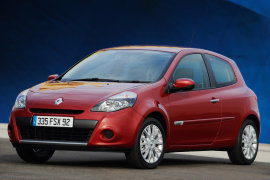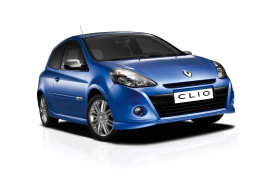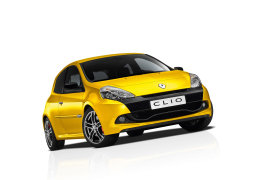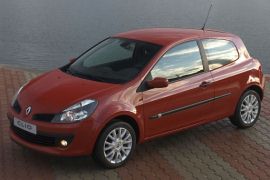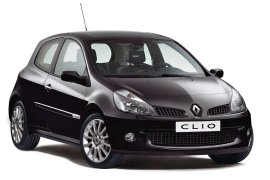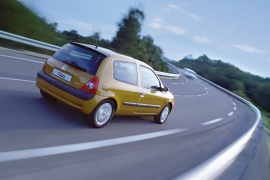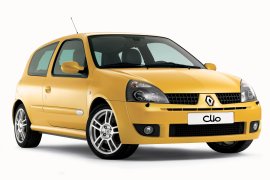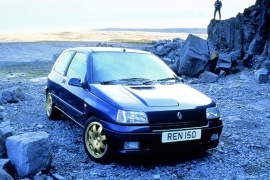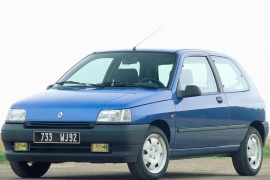RENAULT Clio 3 Doors Models/Series Timeline, Specifications & Photos
First production year: 1990
Engines: Gasoline, Diesel
Body style: Hatchback
Renault introduced a facelifted version for its small-segment contender Clio in 2009, and, as part of the range, the three-door version was upgraded as well.
While other carmakers tried to lure their customers with high-spec (and pricy) vehicles, Renault worked the other way: affordable cars. In 2009 it had to improve the entire lineup due to the stricter Euro 5 emission standards, which required specific safety features. The French carmaker, on the other hand, was already known for its safe vehicles. The three-door Clio was a good choice for young people and, interestingly, delivery companies.
In the three-door version, the Clio still looked fancy with its swept-back headlights on the upper side of the front fenders. A newly designed front bumper sported a wider, black grille on the lower side, which improved the engine's cooling since there was virtually no other grille above. From its sides, the long doors ensured an easy ingress and egress from the car, especially for the front-seat occupants. Strangely though, the pop-out rear windows were not available anymore. Fortunately, the AC unit was standard on most versions.
Inside, Renault was more focused on comfort than on driving experience. It installed comfortable seats at the front without too much bolstering on the sides. At the back, a split-folding bench was good enough to host two adult-sized passengers or three kids.
Under the hood, apart from the special RS version, the carmaker offered economical engines. The least expensive version was the gasoline-powered 1.2-liter unit, while the most fuel-efficient was the 1.5-liter turbodiesel version. Due to poor sales, the 2.0-liter, 140 hp four-mill from the non-facelifted version was axed from the lineup.
Renault introduced the facelift for Clio's third generation in 2009 and surprised its customers with a special version named GT.
It wasn't the first time when Renault thought that a sportier-looking Clio would be a good idea for those who couldn't afford a Clio Renault Sport. That 172 hp pocket-rocket was the benchmark in the small hot-hatch segment, but it wasn't cheap nor fuel-efficient. It was more of a toy than a daily driver. But the carmaker thought that the look might get more customers than the engine and introduced the Clio GT in 2009.
Renault installed a sportier-looking exterior on the three-door Clio. Its front bumper sported a broad grille at the bottom flanked by two arched curved oblique slats. The design team installed round fog lights on the bumper's sides, similar to those from the RS version. Unlike its non-GT siblings, it sported silver door mirrors, while at the back, a roof spoiler adorned the top of the tailgate.
But Renault was not satisfied with some changes on the outside and enhanced the interior with a pair of sport bucket seats with high bolstering for the front occupants. The carmaker placed aluminum trims on the dashboard, while its instrument panel sported white dials with red needles. A set of metallic pedals mimicked those installed in the sportiest Clio on sale.
Under the hood, Renault offered engines that provided enough performance, but they were also fuel-efficient: 1.6-liter gasoline and a 1.5-liter turbo-diesel were the only options. Both were paired with a six-speed manual.
Renault introduced the facelifted version for the third generation of the Clio, and, naturally, it also improved the sportiest version.
This small-sized hot-hatch was known as the king of its class. For Europeans, the Clio Renault Sport, or Clio RS as it was commonly known, was like the Honda Civic Type R in the small segment. And even though it shared its name and platform with the rest of the Clio range, there were more differences between this hot-hatch and its stablemates.
At first glance, the Clio RS sported wider front fenders and enlarged rear quarter panels. Also, the front fascia was different, with an ample black midsection of the bumper and a redesigned apron. The front splitter resembled the wing of an F1 race car as a reminder that Renault was involved in Formula 1. At the back, a double exhaust flanked the rear diffuser from the lower part of the bumper.
Inside, the dashboard was shared with the rest of the Clio range, sporting a similar layout. But it featured a different instrument cluster. In addition, the steering wheel had a 12 o'clock contrast stitching and was covered in Alcantara. The front high-bolstered seats were standard, while a set of Recaro sports seats with integrated headrests and pass-through holes for a six-point harness was offered as an option. The rear bench was fit for two and, apart from the upholstery, was just regular as in any other three-door Clio.
But the magic was under the skin. Renault Sport made the sportier, with stiffer suspension and lower ground clearance. Under the hood, Renault's sports department planted a naturally-aspirated two-liter engine that produced 197 hp (200 PS), which sent them to the front wheels via a six-speed manual. In addition, a hard-core Cup version was also offered, which was lighter and with an even stiffer suspension and thicker anti-roll bars.
Renault Clio reached its third generation in 2005, and it became the European Car of the Year 2006, convincing the jury that it was the benchmark in its segment.
The customers already knew Renault for building reliable supermini vehicles since the Renault 5 in the '70s, and the Clio continued its legacy. Renault made the 2006 Clio in three body styles: hatchback with three and five doors and station wagon. Unlike its predecessor, it was not available as a three-box sedan anymore.
Thanks to its new front fascia that featured large, swept-back headlights and a split-grille, the 2006 Clio distinguished itself from most competitors. The three-door version was available with an aggressive front bumper design, but all shared a similar pattern with a slatted grille on the apron and flanked by round fog lights, depending on the trim level. Since Renault started installing standard AC units in all the range, there was no need for a pop-out rear window anymore in the three-door version.
Inside, the carmaker added Bluetooth connectivity for the entire range, which gained the French carmaker an edge. Its center stack featured the climate control unit and the audio system. Renault made the rounded shapes of the interior and the curved dashboard from higher quality materials when compared to Clio's second generation.
Under the hood, the French carmaker installed a wide engine choice starting with a 1.5-liter turbo-diesel which provided just 70 hp and went up to a 2.0-liter 140 hp unit. The latter was paired either with a four-speed automatic transmission or a six-speed manual.
Already a tradition, the Renault small sports cars date back to the 70s. The peak was reached in the 80s, with almost every manufacturer releasing little bombs on wheels to complete their catalog.
While the previous Clio 2 RS was not very appreciated for its looks, Renault made sure to give back its personality with the Clio 3 RS.
The front optics were more stretched, overflowing towards the hood, while the rear-end looked bouncy with more facets. At the front, the Clio 3 featured wider front and rear fenders, gaping air vents in the front bumper and 17-inch 12-spoke aluminum rims, as well as side sills.
The side vents installed on the front fenders were not just for the look. They were used to vent-out the air trapped in the wheel-well and decrease the aerodynamic front lift forces.
The sporty vehicle’s dimensions were changed, gaining 18 cm in length, 13 cm in width and 6 cm in height. The wheelbase gained 10 cm and changed the car’s road behaviour.
Once seated in the bucket seats, the driving position might have seemed a little high, however, finding the adequate personal settings was easy. Everything fitted perfectly to hand, from steering wheel to controls.
Equipped with an additional feature, the Clio offered the possibility to adjust the steering-wheel both in height and in depth, however, the base version offered a height-adjustable only steering-wheel.
The standard model was well-equipped and the price started at around $24,500 and included electric windows, on-board computer, automatic air conditioning, cruise control and speed limiter.
It was the most radical Renault Clio ever, with a mid-engine and rear-wheel-drive. It was a tribute paid for the famous Renault 5 GT Turbo rally car from 1980.
In 2000, Renault dared to launch the Clio V6 with a mid-engine. It was developed together with Tom Walkinshaw Racing and the car was not built in France but in Sweden. The facelift (or Phase 2 as Renault named it) appeared in 2003 and it was handbuilt in France by Renault Sport.
There was a huge difference between the small family hatchback Clio and the Clio V6. First of all, the car was wider. The enlarged front fenders and the massive rear quarter panels that hosted the air-intakes for engine cooling were characteristic of the model. The Phase 2 featured new headlights, with a triangular shape. In the back, a roof-spoiler was added to the tailgate and two exhaust pipes went through the rear diffuser.
Inside, the car was fitted with sport-bucket seats, Alcantara, a radio-CD, and an air-conditioning system. But the car was not made for comfort. It could barely get some trunk under the front hood. It was tiny and fit for placing the race-helmet and the racing overall in it.
The car was built for racing in the late '90s for a special Renault Clio V6 Trophy. The project was so successful that customers asked if they could have such a car for the road. And Renault said yes. Unlike the race-car, which offered 300 hp, the street version had 255 hp for the Phase 2 version. But both were mated to the same 6-speed gearbox and a limited-slip differential.
Renault had to improve the second generation of its small-segment contender, the Clio, in 2001 due to the introduction of new European standards in terms of safety and emissions.
By 2001, the Clio was already a respected nameplate in the European market. It managed to conquer buyers' hearts with its low price, low running costs, and good reliability. Yet, some engines were just upgraded units developed in the '60s, and they couldn't be adjusted to comply with new regulations. Moreover, many customers complained about the poor night-time visibility due to the weak headlights. Renault fixed all of these with the Clio facelift, or Phase 2, in 2001.
The car was available in a three- or five-door configuration, but all of them sported the same front fascia with larger headlights extended in a curved, triangular shape over the fenders and hood. On the grille, the carmaker installed the badge on a trim named "bird-beak," which later on appeared on other Renault vehicles.
Inside, depending on the trim level, the Clio sported either a cheap fabric or velour. For the sportiest version, available exclusively on the three-door bodywork, it included leather and Alcantara upholstery. Like the non-facelifted version, the 2001 Clio provided enough interior room for up to four passengers, or five if they had to. The folding rear bench expanded the trunk area and made the car a good grocery-getter.
Under the hood, Renault offered the Clio a wide engine choice ranging between 74 hp and 167 hp for the gasoline versions and between 65 hp and 100 hp for the diesel. A four-speed automatic was available for selected engines, while the standard was with a five-speed manual.
RENAULT Clio 3 Doors 1.2L 16V 5AT FWD (75 HP)
RENAULT Clio 3 Doors 1.2L 16V 5MT FWD (75 HP)
RENAULT Clio 3 Doors 1.2L 5MT FWD (60 HP)
RENAULT Clio 3 Doors 1.4L 16V 4AT FWD (98 HP)
RENAULT Clio 3 Doors 1.4L 16V 5MT FWD (98 HP)
RENAULT Clio 3 Doors 1.6L 16V 4AT FWD (110 HP)
Renault refreshed the Clio's second generation in 2001 and, along with the rest of the range, the sportiest version RS also has been upgraded.
The French automaker introduced the RS version as a sporty small-sized hatchback in 1998. That car surprised everyone since it was quicker off the line than many other, more powerful cars. Its high power and low weight were part of the package. When Renault decided to upgrade the entire Clio range and raise it to Euro 2 standards, the RS version went through some changes as well.
At the front, the most significant change was the introduction of larger, triangular-shaped headlights. The front fascia still sported the "bird beak" design element introduced by Patrick le Quement in the early '90s but with a sharper design that marked a slight departure from the bio-design trend. On the lower front bumper, Renault placed an additional grille to help cool the engine, flanked by two scoops for the fog lights. From its profile, the three-door-only RS sported body-colored door handles and mirrors and revealed its light-alloy wheels. Finally, at the back, a small roof spoiler adorned the top of the tailgate.
Inside, customers found Alcantara-wrapped sports seats at the front and a bench fit for two in the back. The instrument panel featrued white-faced dials with red needles, while the leather-wrapped steering wheel completed the sporty interior.
Under the hood, the Renault Sport department installed a naturally-aspirated 2.0-liter engine that provided 174 PS (171 hp) to a five-speed manual gearbox.
Renault was the world Formula 1 Champion with the Williams-Renault team, and they wanted to brag about it, and this is what it came with: the Clio Williams.
When the French carmaker launched the sporty pocket-rocket, it said that it will make under 4,000 of them, and customers rushed their checkbooks to the Renault dealerships. But that number was only for the first series, and Renault made three of them. The most distinct version was the Series III, which sported a sunroof, unavailable on the other two.
Built on the same Renault Clio I platform, the Williams version sported a dark blue color with gold wheels and badges. Even though Williams Engineering was not involved in the project, it donated the brand name for the car as a gesture of good partnership with the French carmaker. But Renault didn’t need the British company to help them build the vehicle since it already was one of the best hot-hatch makers in the world. From the design point of view, the Williams sported a functional scoop on the hood and a lowered suspension. To match that sporty look, the carmaker added flared front and rear fenders to make room for the wider wheels and tires than on the other versions of Clio.
Inside, Renault installed one of the best car seats available for those times. Thanks to their high-bolstered areas and the velour fabric, they offered good side-support and enough comfort for the driver and front passenger. Unfortunately, the rear ones had to sit on the same hard bench as the rest of the range, although the upholstery was identical to the one from the front seats.
Thanks to its short wheelbase and low gravity center, the Clio Williams became a successful race car for tight racetracks and also managed to gain notoriety among the front-wheel-drive rally-cars.
When Renault started to change its car names, the famous Renault 5 was replaced by the Renault Clio. A car that reshaped the small-size European car market. The first generation was launched in 1990 and it was one of the most successful Renault models ever made.
Renault 5 was sold in almost six million units in its 18 years on the market. It was introduced in 1990 as a three and five-door version. But it started with a flat tire since it was available only for left-hand drive. The right-hand drive version for countries like the UK, Malta, Cyprus, India, or Japan (where it was named Lutetia)
sales started in 1991.
The three-door version had a sporty look, even in the base trim level. It was the base model that was further developed to step into the 5's shoes in the motorsport arena, both in the rally and on the tracks. The square headlights, narrow grille and short hood made the car look dynamic.
Inside, there was no exposed metal, unlike in the 5 where some interior panels were left unpadded. The seats were flat for the base models, but depending on the trim level those could have been upgraded to bucket-type. In the rear, the longer wheelbase than of the 5 allowed better legroom.
Various engines were offered for the Clio, starting with a very fuel-efficient unit of 1.2-liter. Apart from the Clio Williams, which was built in 5400 units, the top version was the Clio 16s (S stand for the soupapes – valves in French) and it was offered exclusively on the three-door version.
